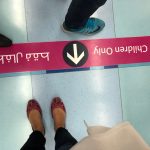Dubai – In the women-only passenger car in Dubai’s metro system bound to the street market of the old city, Souk Deira, I was waiting for my destination with curiosity. In the emirate, the entire metro system has designated carriages which are only for women and children. The one-piece train had a single line in the floor separating the area reserved for women. Subject to an AED 100 fine (approximately USD 27), the limit was respected by the men using the public transport, who glanced more curiously than lustfully into the car.
Despite being one of the most progressive cities in the Middle East, Dubai still have conservative customs. The religion is Islam. The mosques have separate prayer rooms for men or women, so it occurs to me that the women-only passenger car may be more a result of this culture – for them, a way to protect women. I had thought I would be bothered by this separation, but I felt quite comfortable and safe. Since the subway was packed, there were no women in the mixed car, but in other times I myself used the other cars without any problems.
Just as the city itself, the trains were very clean and safe, as well as very low-noise, and inside the women-only passenger car we could see people from all over the world, tourists and working-class women, Eastern and Western, using shorts or headscarves, talking and texting in several languages. All of them in one place, Philippines, Indians, French, English, Chinese, Americans, Brazilians – we were all equal there.
(Continues after gallery)
In the red line bound to Rashidiya, packed at 7 pm – not as packed, however, as the red line of São Paulo’s metro system – I got off at the Union station to take the green line bound to Creek, which was emptier. I could sit, and there I saw an Indian-looking boy with his mother sitting in front of me. He was around five years old, wearing a red shirt and holding a balloon in his tiny hands. The little boy smiled to me and we exchanged smiles and a few glances while he was being embraced by his mother, who looked tired after a workday.
In the UAE, more than 2 million people are Indian, most of the expatriate residents in the country, followed by Pakistanis, Philippines and Bengalis. The total population of the country is approximately nine million residents, most of them foreigners, coming from more than 200 countries. Only in Dubai, there are 245,000 Emiratis and 2.8 million expatriates. The data are from the UAE government and the Dubai Statistics Center.
Mother and son got off at the next station (first picture above), at Baniyas Square, and I kept on for a few more stations until arriving in Al Ras, a 500-meter walk to Souk,. With a childish smile I continued my tour, with a full heart and a sense of accomplishment after a work week in the most global city of the Middle East.
Translated by Guilherme Miranda







